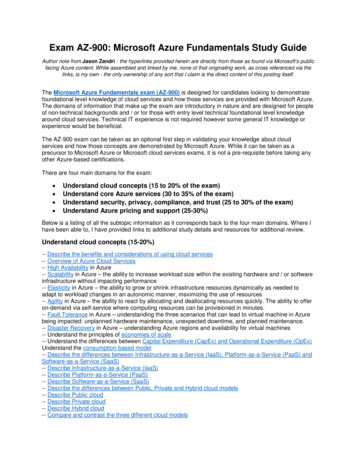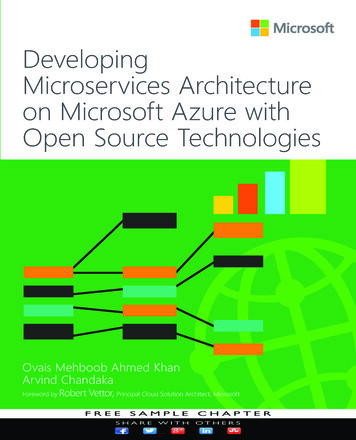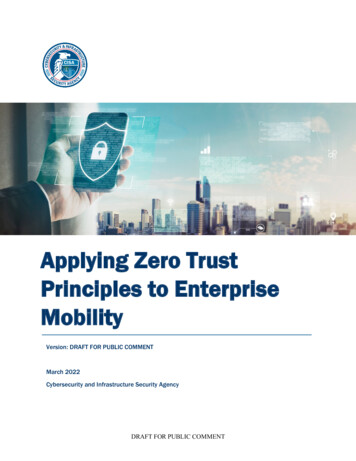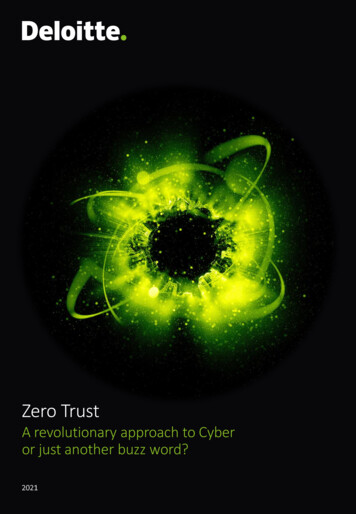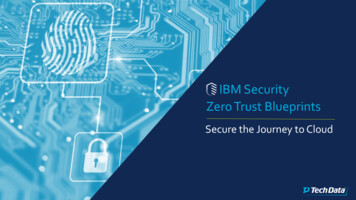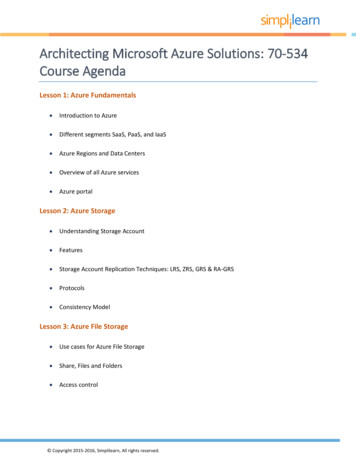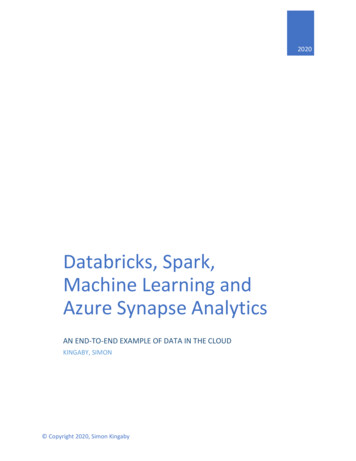
Transcription
Zero Trust Security for Azure Workloads withZscaler Cloud ConnectorReference Architecture
REFERENCE ARCHITECTURE GUIDE FOR AZUREContentsAbout Zscaler Reference Architectures Guides 2Who is this guide for? 2A note for Federal Cloud customers 2Conventions used in this guide 2Finding out more 2Terms and acronyms used in this guide 3Icons used in this guide 4Introduction 5Key Features and Benefits 7New to Zscaler Cloud Connector? 8Cloud Infrastructure Protection using Cloud Connector 9Deploying Cloud Connector VMs via Scripts 11High Availability 11Scalability 13Logging 13Upgrading 14Deployment and Design Options 14Pre-Deployment Considerations 14Deploying Cloud Connector via Scripts 15Deploying Cloud Connector via Terraform 15Deploying Cloud Connector via ARM Template 16Directing Traffic to Cloud Connector 16Forwarding Options 17Choosing the Correct Design Model 19Use Case: Direct to Internet using Zscaler Internet Access 20Use Case: Leveraging VNet Peering 21Use Case: Integrating Zscaler Private Access for Private Cloud Application Access 23Use Case: Securing Traffic Between Clouds with ZPA 25Summary 27 2022 Zscaler, Inc. All rights reserved.1
REFERENCE ARCHITECTURE GUIDE FOR AZUREAbout Zscaler Reference Architectures GuidesThe Zscaler Reference Architecture series delivers best practices based on real-world deployments. Therecommendations in this series were developed by Zscaler’s transformation experts from across the company.Each guide steers you through the architecture process and provides technical deep dives into specific platformfunctionality and integrations.The Zscaler Reference Architecture series is designed to be modular. Each guide shows you how to configure a differentaspect of the platform. You can use only the guides that you need to meet your specific policy goals.Who is this guide for?The Overview portion of this guide is suitable for all audiences. It provides a brief refresher on the platform features andintegrations being covered. A summary of the design follows, along with a consolidated summary of recommendations.The rest of the document is written with a technical reader in mind, covering detailed information on therecommendations and the architecture process. For configuration steps, we provide links to the appropriate Zscaler Helpsite articles or configuration steps on integration partner sites.A note for Federal Cloud customersThis series assumes you are a Zscaler public cloud customer. If you are a Federal Cloud user, please check with yourZscaler account team on feature availability and configuration requirements.Conventions used in this guideClipboard-listNotes call out important information that you need to complete your design and implementation.exclamation-triangleWarnings indicate that a configuration could be risky. Read the warnings carefully and exercise caution beforemaking your configuration changes.The product name ZIA Service Edge is used as a reference to the following Zscaler products: ZIA Public Service Edge,ZIA Private Service Edge, and ZIA Virtual Service Edge. Any reference to ZIA Service Edge means that the features andfunctions being discussed are applicable to all three products. Similarly, ZPA Service Edge is used to represent ZPA PublicService Edge and ZPA Private Service Edge where the discussion applies to both products.Finding out moreYou can find our guides on the Zscaler web site at ectures.You can join our user and partner community and get answers to your questions at https://community.zscaler.com. 2022 Zscaler, Inc. All rights reserved.2
REFERENCE ARCHITECTURE GUIDE FOR AZURETerms and acronyms used in this guideAcronymDefinitionZIAZscaler Internet AccessZPAZscaler Private AccessZTEZero Trust ExchangeACLAccess Control ListsAWSAmazon Web ServicesAZAvailability ZoneCACertificate AuthorityDLPData Loss PreventionDTLSDatagram Transport Layer SecurityIaaSInfrastructure as a ServiceIPSIntrusion Prevention SystemLSSLog Streaming ServiceMITMMan-in-the-MiddleNISTNational Institute of Standards and TechnologyNSSNanolog Streaming ServicePaaSPlatform as a ServiceSaaSSoftware as a ServiceSIEMSecurity Information and Event ManagementSSLSecure Sockets LayerTLSTransport Layer SecurityVMVirtual MachineVNetsVirtual NetworksVPNVirtual Private Network 2022 Zscaler, Inc. All rights reserved.3
REFERENCE ARCHITECTURE GUIDE FOR AZUREIcons used in this guideZscaler Zero Trust ExchangePrivate Data Center LocationZIA or ZPA Service EdgeHeadquarters Office LocationZscaler App ConnectorBranch Office LocationZscaler Cloud ConnectorFactory LocationAzure Load BalancerAuthorized UseAzure Application GatewayBad ActorAzure Virtual MachineData TunnelAzure Application or WorkloadAWS Application or WorkloadGeneric Application orWorkload 2022 Zscaler, Inc. All rights reserved.4
REFERENCE ARCHITECTURE GUIDE FOR AZUREIntroductionThe shift to cloud services has rebuilt the enterprise data center off-premises and outside of traditional securityboundaries. Infrastructure as a Service (IaaS), Platform as a Service (PaaS), and Software as a Service (SaaS) enableorganizations to quickly build out and scale their platforms and services. Securing services across multiple clouds,vendors, and support features requires a different approach than that of the traditional data center.Securing this communication through the layering of legacy Access Control Lists (ACL), on-premises firewalls, and servicechaining has always been both complicated to build and difficult to maintain. Private applications were accessed viaVirtual Private Networks (VPNs) that extended the network to locations in an any-to-any access model. This large, flatnetwork gave users a single location to connect to for access to private applications.Leveraging the cloud breaks these models. You now have multiple vendors across different clouds, products, andservices. Your policy must be interpreted at each cloud and application to determine how best to implement it with thetools available. This risk goes up given a mistake, potentially exposing your organization to a host of network-born attackvectors.Internet accessibleFigure 1. Zero trust moves from exposed network security to user-centric policy enforcementZPAIdeally, an organization’s security policy should be at the foundation of its network design. Connectivity to and fromdevices happens as a product of the security policy and not the other way around. This is the heart of the Zscaler ZeroTrust Exchange (ZTE) model. 2022 Zscaler, Inc. All rights reserved.5
REFERENCE ARCHITECTURE GUIDE FOR AZUREUsers must be authorized before they can connect to that service. Even knowing the application’s hostname and theservices it provides won’t give the attacker any information, as that service won’t resolve until the user authenticates. Yourapplications are effectively hidden from the internet and each other until you define policy to allow access.44SalesSupport4Intranet3ZPA service edgeZIA service edge1Marketing2DeveloperBad ActorFigure 2. Zero trust principles applied to users and workloads1. Authentication – All users must first authenticate to Zscaler. Based on multiple criteria such as user groupmembership, device posture, and location, the user is assigned a set of policies. These include the ability to seeinternal applications.2. ZIA Service Edge – When traffic from users or workloads needs to be routed to the internet, a ZIA Service Edgeinspects the traffic. If your policy allows the traffic out, the return traffic is also scanned for malicious content on itsway back to the user.3. ZPA Service Edge – Traffic from users or workloads bound for other internal applications is handled by ZPA. Basedon the user’s authentication and assigned policy, only approved resources are resolved. All other resources arehidden from unauthorized users as if the services do not exist.4. Cloud Connector – Deployed in front of your internal applications, Cloud Connector creates a set of outboundtunnels to ZIA and ZPA. They decide where the tunnel connects based on policy. 2022 Zscaler, Inc. All rights reserved.6
REFERENCE ARCHITECTURE GUIDE FOR AZUREIn the previous image, your users in marketing have workloads running in Microsoft Azure, and your developers haveworkloads in Amazon Web Services (AWS). All users have access to internal applications in the data center, as well asgeneral internet access. In this case, each user and workload are limited to which applications they can resolve andaccess, based on the policy applied to them.Your marketing user (purple) can access their workloads in Azure, the data center, and the internet based on policy. Yourdeveloper (green) can access their workloads in AWS, the data center, and the internet. Finally, your workloads in Azure,AWS, or your data center can all reach one another and the internet via the ZTE, without the need to set up additionalVPN links. All these connections are subject to the policy you set.Cloud Connector ensures that cloud workloads adhere to organizational security policy when accessing both publicand private endpoints. This is achieved by intelligently forwarding traffic to the Zscaler Internet Access (ZIA) and ZscalerPrivate Access (ZPA) platforms. Cloud Connector also enables multi-cloud connectivity and enforces a security policy forcloud-to-cloud traffic.Key Features and Benefits Security – Secures all inbound and outbound traffic to the internet. The security capabilities available throughthe ZIA platform for server internet access are Transport Layer Security (TLS)/Secure Sockets Layer (SSL), IntrusionPrevention System (IPS), Firewall, Data Loss Prevention (DLP), and more.To learn more about ZIA, visit access. Connectivity – Provides seamless connectivity from private or public cloud applications to the internet. Performance – Ensures better end-user experience and application performance by direct peering relationships withSaaS providers (e.g., Microsoft Office 365, Amazon Web Services, and Microsoft Azure). Reduces Cost – Consolidates multiple products (e.g., Squid proxies, firewalls, third-party NAT appliances, URLfiltering, etc.) into a single solution. Additionally, the same policy applied to user traffic can be applied across thecloud infrastructure. Highly Scalable – Ease of implementation across 1K service accounts in public clouds and single solution scales toconnect 10K server environments in public clouds (e.g., AWS, Azure, etc.). Ease of Deployment – Fully orchestrated deployment for Azure using Terraform scripts or ARM templates. Real-Time Visibility – Dashboards and Insights provide unparalleled visibility into your users and applications, and thehealth of your organization’s applications and servers. 2022 Zscaler, Inc. All rights reserved.7
REFERENCE ARCHITECTURE GUIDE FOR AZURENew to Zscaler Cloud Connector?If this is your first time reading about Zscaler Cloud Connector, we encourage you to watch the following video to see ademo and hear real examples of how Cloud Connector solves today’s security challenges at h-to-secure-server-access-to-the-internet/12804.If you are new to Azure, an Azure Fundamentals course is available at -describe-cloud-concepts/.Zscaler Internet Access (ZIA) provides outbound internet protection for users. Learn more at access.Zscaler Private Access (ZPA) provides private access to applications, not networks. Learn more at ccess.To learn more about zero trust, visit our zero trust microsite at https://www.zscaler.com/it-starts-with-zero.To learn more about the zero trust architecture, we recommend the National Institute of Standards and Technology (NIST)paper at tecture. 2022 Zscaler, Inc. All rights reserved.8
REFERENCE ARCHITECTURE GUIDE FOR AZURECloud Infrastructure Protection using Cloud ConnectorWhen most organizations began to experiment with cloud infrastructure, the first concern was how to protectcommunication to that virtual machine. As cloud knowledge matured, so did the complexity of the workloads that wereshifted to the cloud. With this complexity, it becomes critical to secure traffic: As it moves within the cloud As it enters or exits the cloud While in transit between cloudsSalesIntranetSupportZPA service edgeZIA service edgeFigure 3. Workload communication between private and public applicationsThe communication may be from private workloads (IaaS or physical DC) to public workloads (SaaS internet application)or between private workloads (IaaS to IaaS, or physical DC to IaaS). Securing these communications channels withphysical or virtual appliances is cumbersome and can lead to inconsistent configuration.In the example above, our application sales.azure.internal.safemarch.com sits behind a cloud connector with access toboth ZPA and ZIA platforms. In this model, the workload can reach out to the support workloads in AWS, allowing thesales team to file support and product requests without logging into the support portal. The sales portal is accessed byour intranet workload in our data center to pull deals and rankings for the company dashboard. Finally, our sales workloadcan reach the internet to update our cloud CRM, which in turn only accepts connections from Zscaler IPs for our tenant. 2022 Zscaler, Inc. All rights reserved.9
REFERENCE ARCHITECTURE GUIDE FOR AZUREZscaler Cloud Connector virtual machines extend the security of ZIA and ZPA to cloud native workloads. ZIA protectsyour workload traffic communicating with a public application. ZPA protects your communications between privateworkloads. This allows organizations to secure all workload communications over any network. The Zscaler Zero TrustExchange allows workloads to communicate with each other with a granular security policy applied. Applications-to-Internet Communications may need to access any internet or SaaS destination, such as third-partyAPIs, software updates, etc. with a scalable, reliable security solution that inspects all transactions and appliesadvanced threat prevention and data loss protection controls. Application-to-Application Communication to other public clouds and corporate data centers for multi/hybridcloud connectivity, delivered with better security and a dramatically simplified operational model as compared withtraditional solutions like proxies, virtual firewalls, and IDS/IPS. Application-to-Application Communications within a Virtual Private Cloud by securing process-to-processcommunications. This achieves microsegmentation of traffic with no changes to the application or the network.Cloud Connector is delivered in several form factors. It is available as a virtual appliance in both Amazon Web Servicesand Microsoft Azure, as well as VMs for on-premises deployment.If you are deploying on Microsoft Azure: Zscaler recommends the Standard D2s v3 instance size to support Cloud Connector as it offers the best performanceof 300 Mbps (unidirectional). The appliance is available on the Azure Marketplace at: tplace/apps/zscaler1579058425289.zia cloud connector appFor on-premises deployments, the image requires: VMware ESXi and CentOS/Linux (KVM) images 2 virtual CPUs 4 GB of RAM 2022 Zscaler, Inc. All rights reserved.10
REFERENCE ARCHITECTURE GUIDE FOR AZUREDeploying Cloud Connector VMs via ScriptsCloud Connector VMs can be deployed in either two ways: ARM templates or Terraform scripts. ARM templates allowa user to deploy the appliance directly from the Azure Marketplace via guided workflow, are user-friendly, and workwell with brownfield deployments. Terraform is the most flexible option. Its goal is to be as “hands-off” as possible byautomatically configuring items without user intervention. However, Terraform is more complex in its initial setup. Bothoptions allow you to automate your deployment and achieve the same results. For a detailed look at these deployments,see Deploying Cloud Connector via Terraform and Deploying Cloud Connector via ARM Template in this guide.High AvailabilityCloud Connector leverages Azure Load Balancer functionality to achieve high availability and horizontal scalability. Inthis model, inbound traffic from workload Virtual Networks (VNets) are directed to the front-end IP address of the loadbalancer. When traffic returns from the internet, the Cloud Connector appliance strips off Datagram Transport LayerSecurity (DTLS) encapsulation and forwards the traffic back to the originating workload VNet.Load balancerback-end poolLoad balancerfront-end IPWorkloadLoadbalancerApplicationgatewayZscaler cloudconnectorFigure 4. Cloud Connectors receive outbound traffic from the load balancerZscaler recommends a minimum of two Cloud Connector appliances, each in a different Availability Zone (AZ).Workloads within those same availability zones should then leverage their respective Cloud Connector appliances. If aCloud Connector appliance fails, load balancer functionality automatically redirects traffic to the active appliance in theadjacent AZ. 2022 Zscaler, Inc. All rights reserved.11
REFERENCE ARCHITECTURE GUIDE FOR AZUREWorkload VNetTransit VNetAZ1WorkloadAZ2WorkloadWorkloadFigure 5. Cloud Connectors deployed in redundant pairs across availability zonesBy default, Azure Load Balancer uses a 2-tuple hash (source and destination IP address) to balance traffic. Azure LoadBalancer, by default, probes the HTTP Probe Port every 15 seconds. Two probes must fail before considering an appliancedown (for a total outage of 30 seconds). However, Microsoft Azure allows tuning down to 5 seconds with two failedattempts as necessary (for a total outage of 10 seconds).In addition to the appliance-level redundancy, Cloud Connector also maintains redundant DTLS tunnels to the Zscalercloud. Primary and secondary/backup nodes can be set within the Cloud Connector portal for ZIA, or left as automatic(as is the case with ZPA), wherein the Cloud Connector chooses geographically proximate brokers to connect to.Terraform scripts can be used to instantiate this functionality, or it can be built manually. Zscaler provides a Terraformtemplate for your use at ud-automation-scripts.Learn more about Azure Load Balancer at er/load-balanceroverview. 2022 Zscaler, Inc. All rights reserved.12
REFERENCE ARCHITECTURE GUIDE FOR AZUREScalabilityCloud Connector supports two methods of scaling: vertical and horizontal. With vertical scaling, the Cloud Connector canbe instantiated with a higher footprint of vCPU and RAM. However, throughput and connection capacity scales linearlywith additional resources, and most cloud providers have a bandwidth cap per workload.Cloud Connector can also be scaled horizontally, wherein multiple appliances are instantiated within multiple availabilityzones around a region. Inbound traffic to the Cloud Connector appliance can then be load-balanced across all availablepaths. Zscaler recommends horizontal scaling by deploying additional Cloud Connectors.LoggingCloud Connector can utilize built-in logging functionality through the Insights page of the portal. In this dashboard, youcan review Session Insights, DNS Insights, and ZIA Tunnel Insights. All three facilities allow you to review traffic that passesthrough the Cloud Connector appliance from a different perspective.You can learn more about the insights page at nector/analyzingtraffic-using-insights.For additional information, particularly related to the disposition of this traffic, further insights can be found in the ZIA andZPA pages: ZIA analytics: https://help.zscaler.com/zia/about-dashboards ZPA dashboard and diagnostics: Cloud Connector supports both the Nanolog Streaming Service (NSS) for ZIA use cases and Log Streaming Service (LSS)for ZPA use cases. NSS uses a Virtual Machine (VM) to stream traffic logs in real time to your Security Information andEvent Management (SIEM) system, such as Splunk or ArcSight. LSS operates in a similar way, with the deployment of a ZPAApp Connector VM that receives the log stream and then forwards it to the log receiver.Both services enable real-time alerting and correlation of logs with your other devices. NSS and LSS can be configuredfrom the Cloud Connector portal.Clipboard-listNSS and LSS require separate subscriptions. To learn more about NSS, visit ng-service. To learn more about LSS, visit ervice. 2022 Zscaler, Inc. All rights reserved.13
REFERENCE ARCHITECTURE GUIDE FOR AZUREUpgradingCloud Connector is based on Zscaler OS, so software updates and OS updates are provided by Zscaler. When a CloudConnector is deployed, the software is automatically upgraded to the latest version. A Cloud Connector checks for newsoftware daily and upgrades itself automatically at midnight (local time, based on the deployed cloud region).As mentioned throughout this guide, Zscaler recommends that Cloud Connector appliances be deployed as redundant,high-availability appliances. Specific to software upgrades performed by Zscaler, this ensures that the customer incurs nodowntime. Once an appliance is rebooted to accept a new update, Azure Load Balancer automatically moves traffic overto the redundant, active appliance.Although cloud IaaS providers such as Azure are responsible for ensuring the security and availability of theirinfrastructure, organizations are ultimately still responsible for the security of their workloads, applications, anddata. To learn more about the shared responsibility model, visit ndamentals/shared-responsibility.Deployment and Design OptionsThe following section outlines your options when deploying Cloud Connector. You can design your network using thetools that best match your cloud deployment. We recommend that you review each use case to familiarize yourselfwith the various options, which can be combined to meet your organization’s deployment needs. For example, in manyproduction environments Cloud Connector would be deployed in a Transit/Egress VNet to perform outbound Internetand Zscaler Private Access. Although the use cases do not depend on one another, the concepts and logic depictedwithin them progressively build on one another.Pre-Deployment ConsiderationsCloud Connectors and Availability ZonesZscaler recommends that Cloud Connector appliances be installed in pairs for high availability. When building highavailability pairs of Cloud Connector appliances, Zscaler recommends that each appliance be instantiated withindifferent availability zones. This ensures that individual Cloud Connector appliances exist on physically separate pieces ofunderlying hardware from one another.To learn more about Azure Availability Zones, visit y-zones/azoverview.Network ConnectivityZscaler recommends employing NAT Gateways for internet access. Just like Cloud Connector, a NAT Gateway is alsodeployed in an availability zone. NAT Gateways can be shared across availability zones. Zscaler recommends that NATGateways also be instantiated as a pair, with one gateway in each of the Cloud Connector availability zones.To learn more about Azure NAT Gateway, visit work/nat-gateway/nat-gateway-resource. 2022 Zscaler, Inc. All rights reserved.14
REFERENCE ARCHITECTURE GUIDE FOR AZUREDeploying Cloud Connector via ScriptsCloud Connector can be deployed directly from the Azure Marketplace, through ARM Template scripts or Terraformscripts. While supported, deploying Cloud Connector manually is not best practice outside of lab environments. Zscalerrecommends using scripting to provide consistent deployments. ARM Template scripts in Azure are more “native” to theirrespective platforms, however the preferred method for deploying the appliances is via Terraform.Deploying Cloud Connector via TerraformZscaler Terraform scripts provide complete end-to-end automation to not only instantiate the Cloud Connectorappliances, but all the secondary and tertiary components as well (in a best practice configuration). Terraform scripts canbe downloaded from the Cloud Connector portal in two versions: Starter Deployment Template – Instantiate a Resource Group containing Cloud Connector appliance, VNet, RouteTables, Subnet, NAT Gateway, and Network Security Groups for use cases where only ZIA is required. In addition,Terraform also creates a VM instance for use as a Management/Bastion host in the VNet that Cloud Connector isdeployed in. This host is not a requirement long term, but is recommended for easier troubleshooting and testing. Starter Deployment Template with Load Balancer – Instantiate Cloud Connector in high-availability mode usingAzure Load Balancer, along with required cloud constructs mentioned previously for use cases where high availabilityis a requirement. In addition, Terraform also creates a VM instance for use as a Management/Bastion host in theVNet that Cloud Connector is deployed in. This host is not a requirement long term, but is recommended for easiertroubleshooting and testing. To learn more about Azure Load Balancer, visit lancer/.It is important to note that Terraform does not modify brownfield deployments. When executing Terraform scripts,new VNets, Route Tables, Subnets, and VM instances are spawned to support the current workflow. It is the customer’sresponsibility to integrate the new deployment into their existing environment. This may mean that the new CloudConnector VNet is peered with existing VNets, or that new workloads are installed within the Cloud Connector VNet.Bear this in mind when considering whether Terraform is the correct option to use when integrating with a brownfieldenvironment.For detailed deployment instructions and to find the templates listed above, visit d-automation-scripts. 2022 Zscaler, Inc. All rights reserved.15
REFERENCE ARCHITECTURE GUIDE FOR AZUREDeploying Cloud Connector via ARM TemplateFor customers seeking a more native automation option for deploying Cloud Connector, Zscaler offers ARM Templates.Though ARM Templates can be used in greenfield situations, their value shines when a customer is seeking brownfieldintegration, since many of the prerequisites are already satisfied if a customer has an existing Azure buildout.It should be noted that although ARM Templates scripts work well with brownfield deployments, it is still yourresponsibility to integrate them into the environment.For detailed deployment instructions and to find the templates listed above, visit d-automation-scripts.Directing Traffic to Cloud ConnectorCloud Connector acts as a gateway to cloud workloads. Directing traffic through the Cloud Connector is as simple asmodifying the default gateway route of the workload route table to point to the appliance, or to the Azure Load BalancerIP. In most circumstances, this ensures that both internet-bound traffic destined for ZIA, and DNS traffic that requiresmodification for ZPA Use Cases where redirection to an App Connector is necessary, are appropriately handled.For example, with a single instance of Cloud Connector the workload route table can be updated with a default routeusing the IP address of the service interface of the Cloud Connector appliance as the target. The Cloud Connectorappliance uses the service subnet and route table created during the deployment process. The default route for this routetable should point towards the NAT Gateway, also created in the deployment process. A public subnet and route tableshould have also been created during the deployment process and reference the corresponding internet gateway with itsdefault route.Workload VNet1Route table VNet 10.0.0.0/0 Cloud Connector IP10.0.1.0/24 Route locallyWorkload VNet2Route table VNet 20.0.0.0/0 Cloud Connector IP10.0.2.0/24 Route locallyTransit VNetRoute Table Transit VNet0.0.0.0/0 NAT gateway10.0.1.0/24 VNet110.0.2.0/24 VNet2Figure 6. Default routes for workloads go through the Cloud ConnectorIn the case of hub and spoke, wherein the Transit/Egress VNet is the “hub” and workload VNets are the “spokes,” theTransit VNet should be peered with all workload VNets. A default route in the service subnet route table of the CloudConnector appliance directs traffic towards the NAT Gateway by default. In the workload VNet, a default route is presentto direct traffic across the VNet peering towards the Cloud Connector appliance. As with all network traffic, ensure youhave routing set up as well so that returning traffic from the internet is correctly directed back towards the initiating host. 2022 Zscaler, Inc. All rights reserved.16
REFERENCE ARCHITECTURE GUIDE FOR AZUREWorkload VNet1Route table VNet 10.0.0.0/0 Cloud Connector IP10.0.1.0/24 Route locallyWorkload VNet2Route table VNet 20.0.0.0/0 Cloud Connector IP10.0.2.0/24 Route locallyTransit VNetRoute Table Transit VNet0.0.0.0/0 NAT gateway10.0.1.0/24 VNet110.0.2.0/24 VNet2Figure 7. Transit VNets provide access to one or more private subnetsWhen the Azure Load Balancer is in use in high-availability use cases, Transit/Egress VNet route tables do not change.However, workload route tables are adjusted to use the load balancer front-end IP address
Zscaler Cloud Connector Azure Load Balancer Azure Application Gateway Azure Virtual Machine Azure Application or Workload AWS Application or Workload Generic Application or . Zscaler Private Access (ZPA) provides private access to applications, not networks. Learn more at https://www.zscaler.

